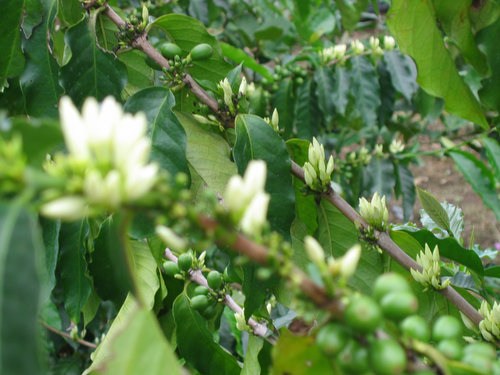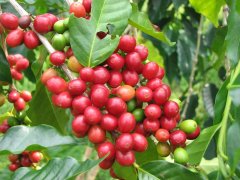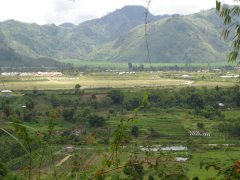How should coffee beans be roasted to taste good? how do Yega Chefe coffee beans bake to taste Yega Chefe?
For professional baristas, please follow the coffee workshop (Wechat official account cafe_style)
"what is the stage of coffee roasting? "asked a colleague who had just qualified as a SCAE barista. In addition to working as a bar, a professional barista needs to have a general understanding of the upstream (coffee agriculture) and middle (roasting) in order to introduce the characteristics of local coffee to guests.

Fried beans like stir-fried vegetables?
In my spare time, I have explained this problem to onlookers many times when I was doing sample sample roasting in the store: to stir-fry coffee is to heat the green green beans in a rolling iron tube until the beans turn dark brown. Many people misunderstand that "fried beans are like fried beans" and need to dance giant shovels like fried chestnuts. In fact, the bean frying machine is electric. In the most commonly used "semi-direct fire" design, the fire burns at the bottom and the iron canister full of coffee beans rotates like a roast chicken. The heat will be dispersed by conduction along the contact surface, or permeated by hot air with convection (convection) in the cylinder. Foreign friends are very professional and will study the effect of the ratio of the two on taste (conductive-convective heat ratio). Using cooking as an analogy, it is probably the difference between dry-fried steak and baked steak at different stages of frying. (note: radiant irradiation is one of the ways of heat transmission, but it is less important than the former two. )
The so-called fried bean stage, to put it simply, is like fried steak "how ripe": visually, the green coffee beans are raw, the light brown ones are half-cooked, and as for black, they are overcooked or even scorched. When you buy coffee beans in the supermarket, the packaging is printed with "medium roast", "full city roast", "French roast" and so on, which are all adjectives of fried beans. However, due to the different standards of different companies, the boutique industry will now use an analyzer called Agtron to quantify colors to facilitate comparison.

Before the first explosion, the second explosion is too strong.
Another way to describe the stir-fried bean stage is to listen to the voice. When making popcorn, the tough outer skin of corn will crack at about 180 degrees Celsius because it can not withstand the pressure caused by internal water evaporation. Fried coffee beans will also explode, and as many as twice. The first first crack is like a burst valley: when water is heated and pressurized, it is caused by breaking the wall of the bean heart. As for the second explosion (second crack), the fiber in the bean is like wood being heated and cracked when burning wood. Its tone is faster and lower than that of the first explosion. When I began to learn coffee, I used to take "the beans are not ripe before the first explosion, and the beans are too strong for the second explosion" as a guide. Up to now, this sentence is still of reference value.
For beginners to stir-fry coffee, you should be used to recording the temperature in the furnace regularly: first preheat the stove to 200 degrees Celsius and then drop the beans, the heat in the furnace will be absorbed by the coffee and the temperature will drop. After about 1 minute, the temperature will bottom at the "temperature recovery point" and gradually rise in the form of parabola. Physically, in addition to darker colors, coffee beans expand in volume, decrease in water content, decrease in density, and lighten in weight. Chemically, coffee beans produce as many as 800 organic compounds through Mena reaction (Maillard Reaction) and caramelization reaction (caramelisation) at different temperatures.
The so-called "roasting curve" is a chart drawn with time and temperature. The environmental factors (indoor temperature and humidity), the temperature of falling beans, the temperature recovery point and the time of the first and second explosion will also be recorded. The baker's job is to rely on experience to control the temperature rise and fall, so as to stir-fry the ideal depth and taste.
Important Notice :
前街咖啡 FrontStreet Coffee has moved to new addredd:
FrontStreet Coffee Address: 315,Donghua East Road,GuangZhou
Tel:020 38364473
- Prev

The most famous producing area of Panamanian coffee describes the flavor and taste of Panamanian coffee.
Exchange of professional baristas Please pay attention to the coffee workshop (Wechat official account cafe_style) Panama coffee flavor and texture is medium and uniform, quite similar to the Blue Mountain temperament. Panamanian coffee is very smooth, full grains, light weight, and perfect acidity balance, its high-quality coffee beans flavor is pure, very characteristic, it is recommended to adopt moderate roasting. Most of the Panamanian coffee belongs to medium and low prices.
- Next

How Golden Manning Coffee is made-visit [Lintong] Lindong, Sumatra
Professional coffee knowledge exchange more coffee bean information please follow the coffee workshop (Wechat official account cafe_style) correct understanding of Golden Manning Coffee, either golden Manning or Golden Manning Giant Island-Sumatra is now known as the representative of the easternmost island of Indonesia in ancient times, in the ancient Spice Islands because it is a remote and mysterious
Related
- Detailed explanation of Jadeite planting Land in Panamanian Jadeite Manor introduction to the grading system of Jadeite competitive bidding, Red bid, Green bid and Rose Summer
- Story of Coffee planting in Brenka region of Costa Rica Stonehenge Manor anaerobic heavy honey treatment of flavor mouth
- What's on the barrel of Blue Mountain Coffee beans?
- Can American coffee also pull flowers? How to use hot American style to pull out a good-looking pattern?
- Can you make a cold extract with coffee beans? What is the right proportion for cold-extracted coffee formula?
- Indonesian PWN Gold Mandrine Coffee Origin Features Flavor How to Chong? Mandolin coffee is American.
- A brief introduction to the flavor characteristics of Brazilian yellow bourbon coffee beans
- What is the effect of different water quality on the flavor of cold-extracted coffee? What kind of water is best for brewing coffee?
- Why do you think of Rose Summer whenever you mention Panamanian coffee?
- Introduction to the characteristics of authentic blue mountain coffee bean producing areas? What is the CIB Coffee Authority in Jamaica?

